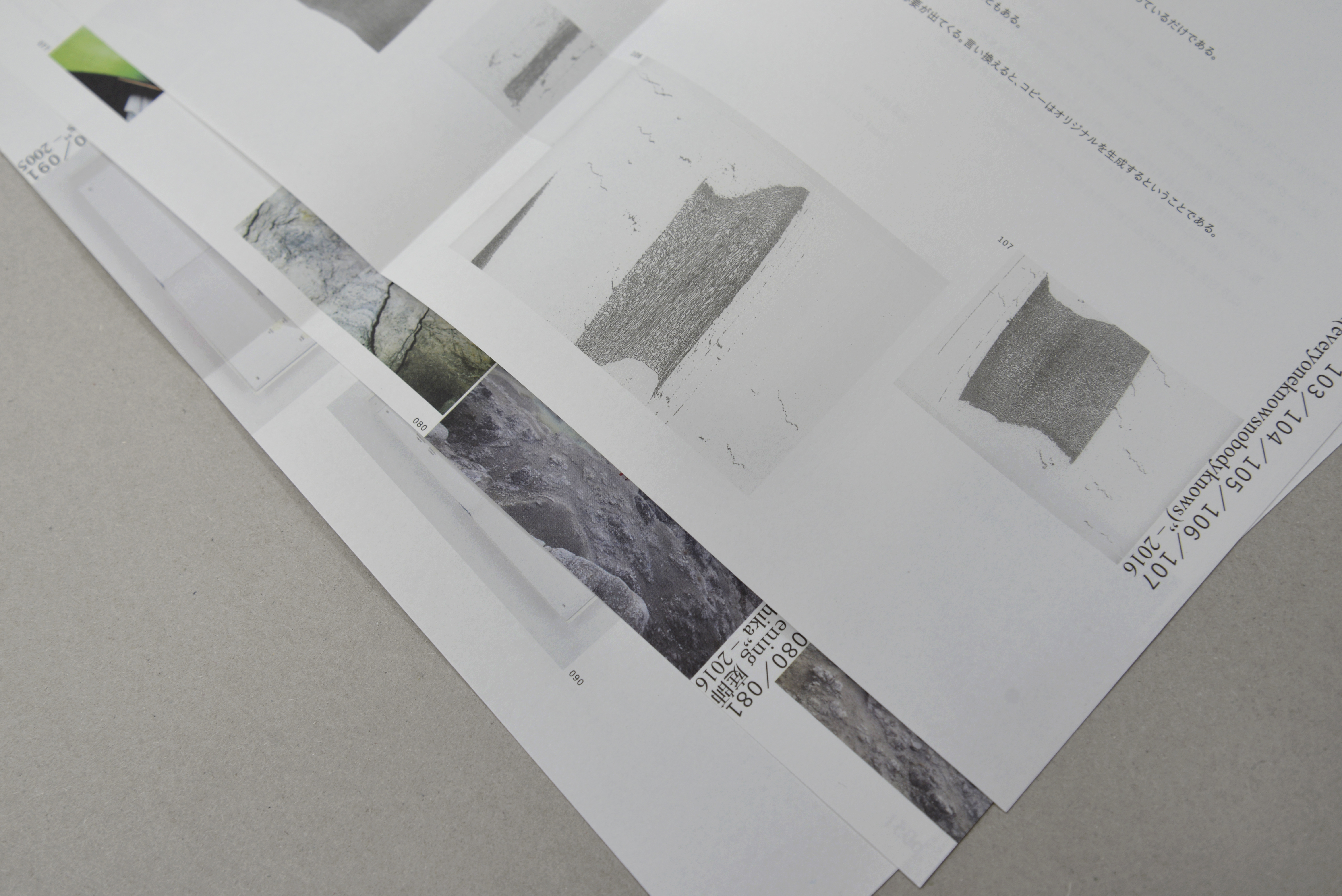








c-SITE#2 Topic : Sample「采样/サンプリング」
Size : 180x240 mm
Contents [88p] + English translation [32p]
Edition of 1000 copies (hand assembled)
Print : Offset
Design : ori.studio
Language : Chinese / Japanese / English
Publisher : da大 in print
ISBN978-1-9995159-1-1
尺寸 :180x240 mm
含讨论内容 [88p] + 英文翻译 [32p]
胶版印刷 + 手工装帧
印量 :1000份
语言:中文/日文/英文
出版社 :da大 in print
ISBN978-1-9995159-1-1
尺寸 :180x240 mm
含讨论内容 [88p] + 英文翻译 [32p]
製本 :offset + hand assembled
エディション :限定1000部
言語 :中国语/日本語/英語
出版社 :da大 in print
ISBN978-1-9995159-1-1
Format :
c-SITE is one of the main publication categories of da大 in print, and is based around an interdisciplinary discussion surrounding a singular topic, exploring it in physical and metaphysical terms. It has been removed from the typical interviewer/interviewee archetype. Rather, it has been formatted to take place in a sequential manner (a → b) , (b → c) … (j → a) where participant (a) will ask a question to participant (b), who after answering will ask a question to the next person down the list (c), so as to achieve a more natural and autonomous form of dialogue.
Our ultimate goal is to analyze the nature and potential of a topic by combining the perspectives of people from various backgrounds, experiences, and ways of thinking, thus maximizing the scope of peoples understanding and ways of thinking.
c-SITE是da大 in print中的主刊出版类别之一。以跨学科和跨领域的方式,围绕某个主题的而进行,从物质和非物质的角度对其进行深度探讨。不受到采访/被采访的单一问答形式所限制,取而代之,以有机、顺序的方式 (a → b) , (b → c) … (j → a) 来开展进行,参与到其中的讨论者 (a),向讨论者 (b) 提出问题,(b) 在作答后再向名单中的下一位对话者进行提问,以此类推,由此来实现一个更加自然且更加自主的对话形式。
我们的最终目的是通过结合来自不同背景、经验和思维方式的人的观点,来深度剖析所探讨一个主题的本质和潜在力量,尽可能扩大人们对其理解和思考的范围
c-SITEはda大 in printのメイン出版物のなかの一つである。一つの学科と分野に拘らず、あるテーマに対して物質的及び非物質的な角度から検討とリレートークを行う形で作られていく。伝統的なインタビューによく見られる質疑回答に代わり、有機的且つ (a → b) , (b → c) … (j → a) のように順番を追うような形で、即ちリレートーク参加者 (a) から (b) に質問し、(b) はそれを回答した上で次の参加者であるcに質問するような形をとることで、より自然で且つ能動的な対談となることを目指す。
また、異なる背景、経験と考え方を持つ方々のご見解をまとめることで、一つのテーマにおいてその本質と潜在力をより深く分析し、それに対する人々の理解と考え方をできる限り幅広く伝えていくことを最終目標としている。
Topic :
Sample -
Living in an environment which is complex and ever-changing, we constantly sample things around us. These things which we interact with exist in a variety of contexts, such as natural or ecological phenomena, sound, temperature, fragments of time, or perhaps even the different fields of thought which people inhabit. The process of consciously collecting, experiencing, questioning, and judging the things which we come across represents ones attitudes and ideas towards specific things. Once sampled from its original context and time, an element begins to change depending on the personal experiences and consciousness of a particular person.
What is the relationship between the memory of a sample and a sample in its original context? What type of thinking happens in the process of sampling? What type of changes to something in regards to scale or essence are possible in the process of sampling? What happens when something sampled is blended with ones own perception and ways of thinking? How can one break the bonds between a sample and its original context or environment? What is the relationship between a sample and time? Can the act of sampling things be reversed? (Can our abstractions be sampled)?
采样 -
生活在繁杂多变的社会中,我们无时不刻不在对身边的事物进行着「采样」这个行为。被采集的事物本身存在于多样的场景之中,也许来自自然生态现象、声音、温度、时间片段,或者是人群对事物的某种思考。对样品有意识的收集、体验、质疑、判断的过程,都代表了人们对特定事物的态度和想法。一个元素一旦在原本的场景、空间、时间中被采集出来,便伴随着人们不同的理解及体验开始发生细微的变化。
样品自身对原场景带着什么样的记忆?事物自身的本质在采集的过程中正在发生着怎样的改变呢?当样品自身的特质在与感性和思考混合后会产生怎样的结果?我们如何破坏样品本身与原环境的束缚?采样与时间存在着什么样的关系?发生了变化的样品与原来的场景又存在着怎样的关系呢?我们对事物进行采集这个行为可以是逆向的吗(我们可以被采集吗)?被采集的事物是否可以在不同的尺度/维度上进行转换呢?
サンプリング -
この複雑で変化の多い世のなかで生きている限り、我々は常に周りの物事に対して「サンプリング」という行為を行わずにはいられない。また、サンプルとして採集される対象そのものも多様化した場面に置かれている。その場面とは、自然現象や音や温度や断片的な時間かもしれないし、或いは物事に対する考え方かもしれない。サンプルに対する意図的な収集、体験、質疑、判断などの過程に、特定の物事に対する人々の態度と考え方が現れる。エレメントというのは元の場所や空間、時間から採集された途端に、人々の異なる理解と体験とともにささやかな変化を始めるのだ。
サンプルは元の場所に対してどんな思い出を持っているのか。物事の本質は、採集過程においてどういう変化を遂げるのか。サンプル自身の特徴って、感性と思考を合わせたらどういう結果をもたらすのか。サンプルと元の環境との束縛はどういうふうに切ったらいいのか。サンプリングと時間の関係とは何なのか。変化を遂げたサンプルは元の場所とどういう関係を持つのか。物事に対する採集という行為は、逆方向でもあり得るのか(我々が逆に採集されたりするのか)。採集された物事は異なるスケール/時空間上で転換できるのか。
© 2019, da大 in print